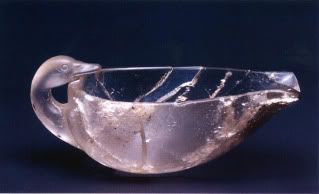Mycenaean Rock Crystal Duck
This lovely bowl was carved in the shape of a duck from a single piece of rock crystal, and dates from between 1600-1550 B.C. The rock crystal is Egyptian, but the carving appears to be Mycenaean. At this time, Mycenaean artists began imitating the exquisite stone vases and vessels which came to them not only through their Minoan and Cycladic contacts, but also from farther-flung regions: Egypt, Syria, and Canaan.
Unlike other arts, such as weaving and fresco painting, which began as imitation but soon took on its own, unique Mycenaean character, Mycenaean stone carving remained true to its foreign prototypes.
The crystal duck bowl was discovered in Grave O in Mycenae’s Grave Circle B.
